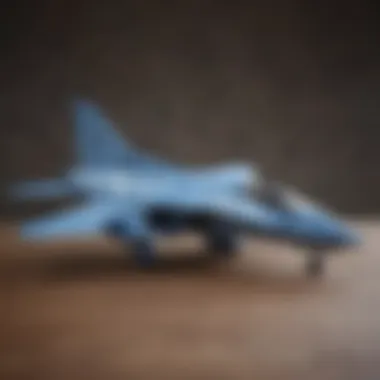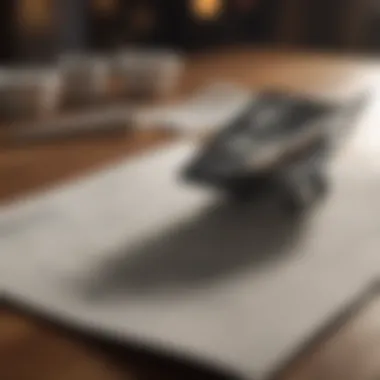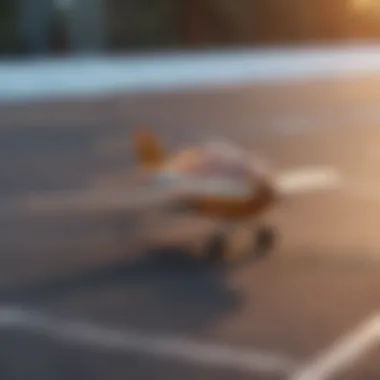Mastering the Art of Crafting a Flawless Paper Plane: An Expert Guide


Techniques and Training
When embarking on the journey of crafting the perfect paper plane, one must hone their skills through meticulous practice and dedication. Mastering the art of paper-folding requires not only creativity but also precision in executing intricate folds. Advanced techniques such as the reverse fold, petal fold, and valley fold play a crucial role in shaping the aerodynamics of your paper aircraft. To achieve mastery in this craft, one must engage in training exercises designed to enhance dexterity, focus, and attention to detail. Professional paper-folding enthusiasts recommend following a structured routine to improve strength and agility, essential for constructing flawless paper planes.
Safety and Risk Management
As with any precision-driven endeavor, safety and risk management are paramount in the world of paper plane construction. Adhering to established safety protocols is vital to prevent accidents and ensure a smooth crafting process. Understanding potential hazards, such as paper cuts and folding mishaps, is crucial for mitigating risks effectively. By implementing strategies for emergency preparedness and risk mitigation, one can approach paper plane construction with confidence and peace of mind. Remember, a safe environment is the key to unlocking your creativity and fostering a secure crafting experience.
Events and Competitions
For the ardent paper-folding enthusiast, participating in paper plane events and competitions can be a thrilling experience. Engage in upcoming gatherings to showcase your skills, learn from fellow enthusiasts, and immerse yourself in the vibrant paper-folding community. Stay updated on the latest championship competitions, where top paper plane constructors converge to display their prowess. Explore profiles of veteran competitors and gain insights into their techniques and approaches. Get a glimpse of recent events, relive the highlights, and uncover the tactics that set champions apart from the rest.
Lifestyle and Community
Beyond the intricacies of paper plane construction lies a rich tapestry of lifestyle elements that define the paper-folding community. Dive into the culture of paper-folding, discovering how enthusiasts balance their craft with physical well-being and mental harmony. Explore tips and recommendations for maintaining a healthy lifestyle while indulging in the art of paper-folding. Uncover the mental benefits of engaging in this creative pursuit, connecting with like-minded individuals who share your passion for precision and innovation.
Introduction
Who could have thought that the simple act of folding a piece of paper could lead to the creation of an aerodynamic marvel? In this detailed guide, we will embark on a journey delving into the meticulous process of crafting the perfect paper plane. Whether you're a novice seeking to hone your skills or a seasoned paper-folding enthusiast looking to elevate your creations, this comprehensive manual is your gateway to mastering the art of paper aircraft engineering.
We will break down each critical aspect, from the selection of the ideal paper type to the intricate fold patterns that can make or break your plane's flight capabilities. By understanding the dynamics behind paper plane construction, you will gain valuable insights into aerodynamics and center of gravity, essential factors in achieving optimal flight performance. Through a step-by-step approach, we will explore basic folds, advanced techniques, component assembly, and fine-tuning adjustments to ensure your paper plane soars with precision and grace.
Prepare to immerse yourself in the world of paper crafting as we unveil the secrets to crafting flawless paper planes. Whether you aim for maximum stability, soaring distances, or elegant aesthetics, this guide will equip you with the expertise needed to engineer paper aircraft that defy expectations and amaze onlookers. Join us on this journey of discovery and innovation as we elevate the humble paper plane to new heights of excellence.
Choosing the Right Paper


Crafting the perfect paper plane requires meticulous attention to detail, starting with the fundamental choice of paper. The selection of paper is a critical factor that influences not only the aesthetics but also the aerodynamics of the final aircraft. Opting for the right paper can elevate your paper plane crafting experience to new heights, ensuring a seamless flight and elegant design. By focusing on selecting the optimal paper, you pave the way for a successful paper plane creation journey.
Weight and Thickness
In the realm of paper plane construction, the weight and thickness of the paper play a significant role in defining the overall performance and flight characteristics of the aircraft. The overarching goal is to achieve optimal flight dynamics through judicious selection of paper weight and thickness. Thicker paper tends to offer sturdiness and structural integrity, enhancing the plane's durability during flight. On the other hand, lighter paper can contribute to increased lift and agility, allowing for swift maneuvers in the air.
Considerations for Optimal Flight
Delving deeper into the specifics of paper weight and thickness, considerations for optimal flight extend beyond mere numbers. The key aspect lies in striking the perfect balance between weight and thickness to achieve the desired flight behavior. When selecting paper for crafting a paper plane, it is essential to consider the impact of weight on propulsion and aerodynamics. Lighter paper can lead to improved glide and longer airborne time, while thicker paper offers stability and resilience against environmental factors.
Highlighting the inherent versatility of paper planes, the choice of paper weight and thickness can be tailored to meet distinct flying objectives. Experimenting with different paper types allows enthusiasts to fine-tune their creations according to specific preferences. Whether aiming for long-distance flights or intricate aerial maneuvers, understanding the intricate interplay between paper weight, thickness, and flight dynamics is paramount for crafting the perfect paper plane.
Understanding Paper Plane Dynamics
Crafting the Perfect Paper Plane involves a deep understanding of the dynamics behind this seemingly simple yet intricately engineered flying object. In this section, we explore the vital role of comprehending these dynamics to elevate your paper aircraft construction skills. From aerodynamics to center of gravity, each aspect plays a crucial part in achieving the ultimate flight performance.
Aerodynamics at Play
How Shape Affects Flight
Delving into the specifics of aerodynamics, we unravel the impact of shape on the flight capabilities of your paper plane. The shape of your aircraft determines its ability to glide smoothly through the air, influencing distance and stability. By crafting the optimal shape, you enhance the overall aerodynamic efficiency, resulting in superior flight characteristics. Understanding how different shapes perform in various conditions is key to crafting a paper plane that stands out in performance.
Center of Gravity
Balancing for Stability
Center of Gravity stands as a cornerstone in achieving stability for your paper creation. Balancing this crucial point ensures that your plane maintains a steady flight path and resists unwanted deviations. By strategically placing the center of gravity, you optimize the stability of your aircraft, allowing it to navigate air currents with precision. Mastering this aspect guarantees that your paper plane remains steadfast in its trajectory, enhancing its overall performance and flight duration.


Mastering the Folds
Mastering the Folds in the Crafting the Perfect Paper Plane guide plays a pivotal role in achieving aerodynamic excellence. Understanding the intricacies of paper folding directly impacts the flight performance and stability of the paper plane. It is crucial to grasp the fundamentals of folding techniques to ensure precise execution and optimal flight dynamics. Proficiency in folding contributes significantly to the overall success of crafting a high-performance paper aircraft.
Basic Folds
Basic Folds are the foundation of paper plane construction, laying the groundwork for more advanced techniques. Step-by-step Instructions for Basic Folds provide a systematic approach to creating the initial structure of the paper plane. Each fold is carefully executed to achieve the desired shape and stability of the aircraft. The strategic placement of folds determines the aerodynamic efficiency and flight trajectory of the paper plane. Basic Folds serve as the building blocks for intricate folding patterns, enhancing the overall aesthetics and performance of the aircraft.
Advanced Techniques
Incorporating Advanced Techniques such as Enhancing Precision and Aesthetics elevates the complexity and functionality of the paper plane. Precision in folding ensures symmetrical alignment and uniformity in the aircraft's design, resulting in improved aerodynamic properties. Aesthetics play a crucial role in enhancing the visual appeal of the paper plane, making it more engaging and attractive. Advanced Techniques bring a level of sophistication to paper plane crafting, showcasing precision engineering and artistic craftsmanship. Despite the intricacy involved, mastering these techniques enhances the overall performance and aesthetic value of the final paper plane design.
Assembling the Components
When it comes to crafting the perfect paper plane, Assembling the Components plays a critical role in ensuring the structural integrity and aerodynamic performance of your paper aircraft. It serves as the culmination of all your efforts in choosing the right paper, understanding plane dynamics, and mastering the folds. Assembling the Components not only brings together the different elements of your paper plane but also sets the stage for its flight capabilities. From aligning the folds to securing the edges, each step in this process contributes to the overall stability and performance of the final aircraft. A meticulous approach to assembling ensures that your paper plane not only looks pristine but also flies with precision and grace. By focusing on the details of Assembling the Components, you can elevate your paper plane crafting skills to new heights.
Sealing the Edges
In the realm of paper plane construction, Sealing the Edges stands out as a crucial step that directly impacts the structural integrity of your aircraft. Ensuring Structural Integrity through proper edge sealing helps in maintaining the shape of the plane, preventing air leakage, and enhancing its durability. The key characteristic of this method lies in its ability to provide a solid closure to the edges, minimizing fraying and ensuring that the folds stay intact during flight. Using techniques like folding, creasing, or even the application of adhesive can aid in Sealing the Edges effectively. This approach is a popular choice for paper plane enthusiasts due to its simplicity and effectiveness in maintaining the overall shape and form of the aircraft. The unique feature of Sealing the Edges lies in its ability to reinforce the structural strength of the paper, increasing resilience and making the plane more resistant to turbulence or rough handling. While Sealing the Edges adds an extra layer of stability, it's essential to strike a balance between secure sealing and maintaining the aerodynamic principles crucial for optimal flight performance in the context of this article.
Fine-Tuning and Adjustments
Fine-tuning and adjustments in the realm of crafting the perfect paper plane play a paramount role in elevating your creation from mundane to marvelous. This crucial aspect involves meticulous modifications to enhance the performance, stability, and aerodynamics of your paper aircraft. By delving into the nuances of fine-tuning, you can optimize every fold and crease to achieve maximum flight efficiency.
Engaging in fine-tuning and adjustments provides a plethora of benefits for paper plane enthusiasts. It allows for personalized tailoring of the plane's characteristics to suit your specific preferences and intended flight path. Through careful adjustments, you can fine-tune the balance, weight distribution, and lift of the plane, ensuring it soars gracefully through the air. Embracing this process also sharpens your understanding of aerodynamics, as you experiment with different configurations to achieve the perfect flight.
When delving into fine-tuning and adjustments for your paper plane, several considerations warrant attention. Ensuring symmetrical folds and precise alignments is critical for maintaining stability during flight. Balance adjustments, such as shifting the center of gravity slightly, can dramatically influence how the plane glides through the air. Additionally, exploring various folding techniques and tweaks enables you to pinpoint the optimal design for enhanced performance.


Refining Performance
Optimizing Stability and Distance
Optimizing stability and distance is a pivotal aspect of refining the performance of your paper plane. This entails fine-tuning the plane's center of gravity, wing configurations, and overall weight distribution to achieve a harmonious balance between stability and distance covered. The key characteristic of optimizing stability and distance lies in its ability to enhance the plane's flight duration and trajectory, making it a popular choice among paper plane enthusiasts.
An advantageous feature of optimizing stability and distance is its versatility in catering to diverse flying preferences. Whether you aim for long-distance flights or graceful mid-air maneuvers, this approach allows you to customize the plane's flight dynamics accordingly. By focusing on optimizing stability, you can minimize erratic movements and ensure a smooth gliding experience for your paper creation.
Furthermore, the unique feature of optimizing stability and distance lies in the nuanced adjustments you can make to achieve desired flight outcomes. From subtle weight distributions to strategic wing adjustments, this method empowers you to fine-tune the plane's performance with precision. While it enhances flight endurance and predictability, meticulous attention to detail is required to strike the perfect balance between stability and distance in this article.
Testing and Iteration
In the realm of crafting the perfect paper plane, the stage of Testing and Iteration emerges as a critical juncture where theories meet reality in a dance of precision and refinement. Every fold made, paper selection deliberated upon, and aerodynamic consideration pored over culminates in this pivotal phase. Testing and Iteration serve as the litmus test for the culmination of meticulous craftsmanship and engineering prowess, offering a gateway to unparalleled improvements and advancements in the flight dynamics of your paper aviator.
Embracing the ethos of empirical observation, Testing and Iteration beckon the aspiring paper plane aficionado to delve into the empirical process of trial and refinement. It's a canvas where hypotheses are pitted against real-world scenarios, as each adjustment reverberates through the intricate tapestry of aerodynamic nuances. The beauty of this phase lies in its iterative nature, allowing for incremental enhancements propelled by astute analysis and keen observation.
Within the labyrinth of Testing and Iteration, a myriad of factors awaits scrutiny - from the precision of folds to the influence of weight distribution and aerodynamic proficiency. Each flight serves as a chapter in the narrative of continuous improvement, guiding the practitioner towards mastery through meticulous adjustments and data-driven insights. The iterative nature of this process instills a sense of discipline and scientific inquiry, fostering a spirit of relentless pursuit towards perfection.
As the paper plane takes flight once more, armed with insights from previous iterations, the practitioner is poised to witness the fruits of their labor unfold. Every tweak, every fold meticulously examined, every adjustment made with purpose, culminates in a moment of truth exemplified by the artistry of flight. Testing and Iteration conspire to elevate the paper plane from mere creation to a sentient being of aerodynamic finesse, embodying the tenacity and creativity of its maker.
In essence, Testing and Iteration encapsulate the essence of growth and evolution within the realm of crafting paper planes. It's a playground of innovation and precision, where each flight represents a canvas for improvement and refinement. As you embark on this journey of iterative design and relentless testing, remember - the true beauty of crafting the perfect paper plane lies not just in its flight but in the spirit of discovery and refinement that propels it forward.
Conclusion
Crafting the perfect paper plane is not merely an idle pastime; it is an art form that demands precision, patience, and a keen understanding of aerodynamics. Throughout this guide, we have traversed the intricate realms of paper selection, fold mastery, and component assembly, all culminating in the creation of an aerodynamic masterpiece that defies gravity.
The significance of mastering the art of paper plane construction extends beyond mere amusement; it instills a sense of achievement and satisfaction in the meticulous process of transforming a simple sheet of paper into a soaring marvel of engineering. By honing your skills in weight selection, fold execution, and edge sealing, you pave the way for boundless creativity and innovation in the realm of paper aviation.
In a world captivated by technology and digital pursuits, the simple pleasure of crafting and launching a perfectly designed paper plane harkens back to a time when creativity knew no bounds and imagination reigned supreme. Embracing the principles of aerodynamics and structural integrity opens up a world of possibilities, where each fold and crease holds the promise of enhanced flight performance and aerodynamic efficiency.
As you embark on your journey to master the art of paper plane crafting, remember that every fold, cut, and adjustment contributes to the overall success of your aerodynamic creation. The meticulous attention to detail and the unwavering pursuit of perfection are not merely optional but intrinsic to the art of paper plane engineering.
Through testing, refining, and iterative improvements, you have the opportunity to push the boundaries of traditional paper folding and elevate your creations to new heights of precision and performance. Whether your goal is to achieve maximum distance, optimal stability, or aesthetic elegance, this guide equips you with the knowledge and skills to engineer paper planes that defy expectations and soar to greatness.















